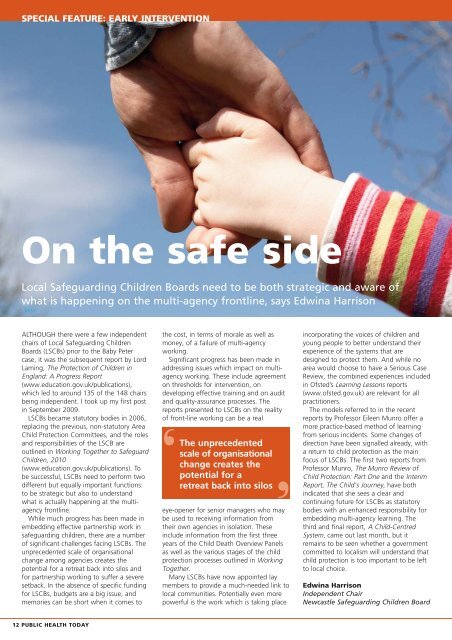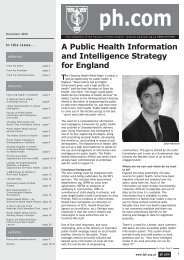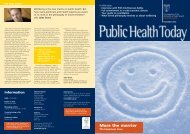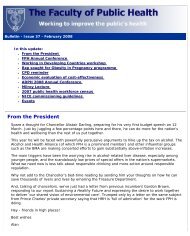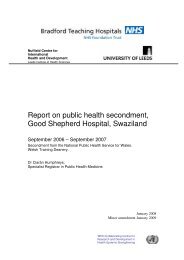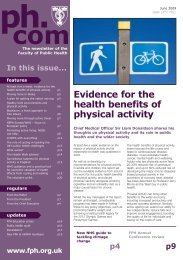PHT June 2011_Jan 10 - UK Faculty of Public Health
PHT June 2011_Jan 10 - UK Faculty of Public Health
PHT June 2011_Jan 10 - UK Faculty of Public Health
Create successful ePaper yourself
Turn your PDF publications into a flip-book with our unique Google optimized e-Paper software.
SPECIAL FEATURE: EARLY INTERVENTION<br />
On the safe side<br />
Local Safeguarding Children Boards need to be both strategic and aware <strong>of</strong><br />
what is happening on the multi-agency frontline, says Edwina Harrison<br />
6mm<br />
ALTHOUGH there were a few independent<br />
chairs <strong>of</strong> Local Safeguarding Children<br />
Boards (LSCBs) prior to the Baby Peter<br />
case, it was the subsequent report by Lord<br />
Laming, The Protection <strong>of</strong> Children in<br />
England: A Progress Report<br />
(www.education.gov.uk/publications),<br />
which led to around 135 <strong>of</strong> the 148 chairs<br />
being independent. I took up my first post<br />
in September 2009.<br />
LSCBs became statutory bodies in 2006,<br />
replacing the previous, non-statutory Area<br />
Child Protection Committees, and the roles<br />
and responsibilities <strong>of</strong> the LSCB are<br />
outlined in Working Together to Safeguard<br />
Children, 20<strong>10</strong><br />
(www.education.gov.uk/publications). To<br />
be successful, LSCBs need to perform two<br />
different but equally important functions:<br />
to be strategic but also to understand<br />
what is actually happening at the multiagency<br />
frontline.<br />
While much progress has been made in<br />
embedding effective partnership work in<br />
safeguarding children, there are a number<br />
<strong>of</strong> significant challenges facing LSCBs. The<br />
unprecedented scale <strong>of</strong> organisational<br />
change among agencies creates the<br />
potential for a retreat back into silos and<br />
for partnership working to suffer a severe<br />
setback. In the absence <strong>of</strong> specific funding<br />
for LSCBs, budgets are a big issue, and<br />
memories can be short when it comes to<br />
the cost, in terms <strong>of</strong> morale as well as<br />
money, <strong>of</strong> a failure <strong>of</strong> multi-agency<br />
working.<br />
Significant progress has been made in<br />
addressing issues which impact on multiagency<br />
working. These include agreement<br />
on thresholds for intervention, on<br />
developing effective training and on audit<br />
and quality-assurance processes. The<br />
reports presented to LSCBs on the reality<br />
<strong>of</strong> front-line working can be a real<br />
The unprecedented<br />
scale <strong>of</strong> organisational<br />
change creates the<br />
potential for a<br />
‘retreat back into silos<br />
‘<br />
eye-opener for senior managers who may<br />
be used to receiving information from<br />
their own agencies in isolation. These<br />
include information from the first three<br />
years <strong>of</strong> the Child Death Overview Panels<br />
as well as the various stages <strong>of</strong> the child<br />
protection processes outlined in Working<br />
Together.<br />
Many LSCBs have now appointed lay<br />
members to provide a much-needed link to<br />
local communities. Potentially even more<br />
powerful is the work which is taking place<br />
incorporating the voices <strong>of</strong> children and<br />
young people to better understand their<br />
experience <strong>of</strong> the systems that are<br />
designed to protect them. And while no<br />
area would choose to have a Serious Case<br />
Review, the combined experiences included<br />
in Ofsted’s Learning Lessons reports<br />
(www.<strong>of</strong>sted.gov.uk) are relevant for all<br />
practitioners.<br />
The models referred to in the recent<br />
reports by Pr<strong>of</strong>essor Eileen Munro <strong>of</strong>fer a<br />
more practice-based method <strong>of</strong> learning<br />
from serious incidents. Some changes <strong>of</strong><br />
direction have been signalled already, with<br />
a return to child protection as the main<br />
focus <strong>of</strong> LSCBs. The first two reports from<br />
Pr<strong>of</strong>essor Munro, The Munro Review <strong>of</strong><br />
Child Protection: Part One and the Interim<br />
Report, The Child’s Journey, have both<br />
indicated that she sees a clear and<br />
continuing future for LSCBs as statutory<br />
bodies with an enhanced responsibility for<br />
embedding multi-agency learning. The<br />
third and final report, A Child-Centred<br />
System, came out last month, but it<br />
remains to be seen whether a government<br />
committed to localism will understand that<br />
child protection is too important to be left<br />
to local choice.<br />
Edwina Harrison<br />
Independent Chair<br />
Newcastle Safeguarding Children Board<br />
12 PUBLIC HEALTH TODAY


